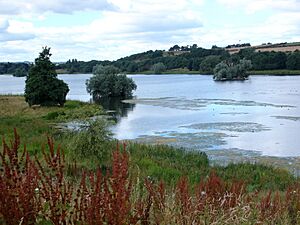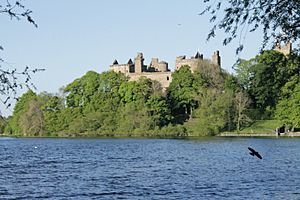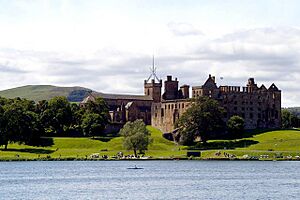Linlithgow Loch facts for kids
Linlithgow Loch is a beautiful freshwater lake located just north of the historic town of Linlithgow in West Lothian, Scotland. It's the largest natural freshwater loch in the Lothian area, stretching about 1.3 kilometers long and 0.4 kilometers wide. Even though it's quite large, it's not very deep, averaging about 2.3 meters and reaching a maximum depth of 9.2 meters.
Several small streams, like the Hatchery Burn and Bonnytoun Burn, feed water into the loch. On its western side, the Mill Burn drains water away, eventually flowing into the River Avon. The name 'Linlithgow' actually comes from the loch itself! It's from an old British language, llyn laith cau, which means "lake in the damp hollow."
Look closely, and you might spot two small islands, Cormorant Island and The Rickle. Scientists believe these are the remains of ancient homes called crannogs, built about 5,000 years ago! Crannogs were often built on artificial islands in lakes for protection.
Contents
A Glimpse into History at Linlithgow Loch
Linlithgow Loch has seen many interesting events over the centuries. One famous moment happened in the winter of 1847-1848. The loch froze solid, becoming the perfect stage for a huge sporting event called the Grand Curling Match. A famous artist named Charles Lees even painted this exciting scene, capturing the fun and energy of the day.
Fun Activities at Linlithgow Loch
Linlithgow Loch is a great place for outdoor activities, especially if you love being on or near the water!
Fishing for Trout
For a long time, Linlithgow Loch was famous for its wild brown trout. Today, most anglers come to catch rainbow trout, which are regularly released into the loch by the Forth Area Federation of Anglers. It's a popular spot for a peaceful day of fishing.
Boating Adventures
Until 2021, the Low Port Centre offered many exciting water sports on the loch. Kids and adults could learn to sail, canoe, kayak, and even windsurf! While the center's building is currently closed, the loch remains a beautiful place to enjoy the scenery.
Protecting Our Loch: Conservation Efforts
Keeping Linlithgow Loch healthy is very important for all the plants and animals that live there, and for people who enjoy visiting. Sometimes, water running off from nearby towns and farms can carry things that make the loch's water less healthy. This can lead to something called eutrophication, where too many nutrients cause tiny green plants (algae) to grow too much. These algal blooms can harm other wildlife and make the water less clear.
A Special Place for Nature
Because of its unique natural features and the special plant communities it supports, Linlithgow Loch is recognized as a Site of Special Scientific Interest (SSSI). This means it's a protected area, and efforts are made to keep its environment safe and thriving for future generations to enjoy.




